It is an early Friday morning and no one, except security, is at the Advanced Research Centre at the University of Glasgow - just me and a few other student volunteers, who are diligently preparing the reception desk, the sponsor stands and setting up the boards where the posters will be put on display. So begins the day-long journey of scientific discovery at the Glasgow Early Career Life Sciences Symposium.
After months of relentless planning and organising, the event (which was long overdue since the 2018 Young Life Scientists’ meeting in Glasgow) successfully saw the light of the day. As one of the principal architects of this endeavour, I'd like to share the story of this unique venture and the lessons learned from its organisation.
Organising any event is never just down to one person; it takes a team to make it happen. We wanted to establish an inclusive committee with representation across all levels from undergraduate to postgraduate and beyond. Scientific symposia are a critical part of the academic landscape, providing opportunities for networking, collaboration, and learning. With the pandemic limiting in-person events for so long, we were keen to involve our Glasgow undergraduate and postgraduate community as much as possible to give them a taste of something different, away from a diet of online lectures and meetings. Our vision was to create an event designed specifically for early career researchers (ECRs) to share their ideas, receive critical feedback, and build relationships with other scholars and industry professionals in a friendly informal environment.
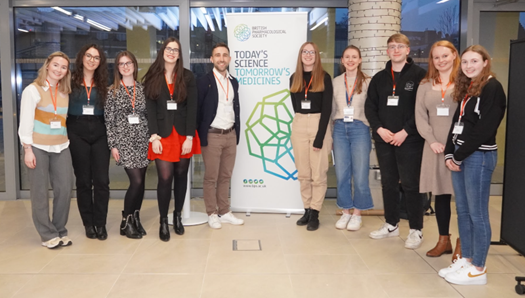
Members of the ECR organisation team on the day.
Whilst we devised the original scientific programme with cardiovascular and neuroscience research in mind, we opened the meeting to broader areas of life sciences following expressions of interest from ECRs wanting to join and present. We set up a website to showcase the event and we quickly received abstract submissions. Our symposium was structured to stimulate discussions and encourage knowledge exchange through a combination of keynote seminars, short talks, flash talks, poster presentations and career development workshops, with many of the sessions dedicated to ECR presenters.
As with any event, things rarely run smoothly or completely to plan. One of our invited speakers, Dr. Maria Majellaro from the University of Santiago de Compostela, experienced weather-related travel disruption leading to cancellation of her flight. In the past, this would have resulted in a race to find an alternative speaker. On this occasion we were able to readily adopt a hybrid meeting format to allow Maria to Zoom into the Symposium from her hotel room with minimal disruption to schedule. Maria opened the meeting and provided insights into how ECRs could get involved in the European Research Network on Signal Transduction (ERNEST) and encouraged us to join this cost action. The aim of ERNEST is to develop a diverse multidisciplinary network whilst creating a common, holistic map of signal transduction. Next up, we had Professor Frank Gunn-Moore from the University of St Andrews who introduced us to how his breakthrough ideas come from a mixture of sciences: from physics to chemistry to biology. Professor Ingeborg Hers from the University of Bristol then talked about her research on Proteolytic Target Chimeras (PROTACs), a hot topic in pharmacology. We also had a speaker coming from industry, Dr. Clíona MacSweeney from Sosei Heptares, who talked about targeting novel G protein-coupled receptors in neuropsychiatric disorders, as well as scientific research in industry. Being a symposium aimed at ECRs, our last speaker was a PhD student, Beth Eyre from the University of Sheffield, who brought together both of our symposium topics, linking Alzheimer’s disease with vascular disorders such as atherosclerosis. On top of these fantastic speakers, we also invited our attendees to submit abstracts to share their research. Out of the many submissions, we selected four which formed the series of short oral communications. The topics of the four oral communication sessions were: pulmonary hypertension, heart failure, stroke and membrane protein production.
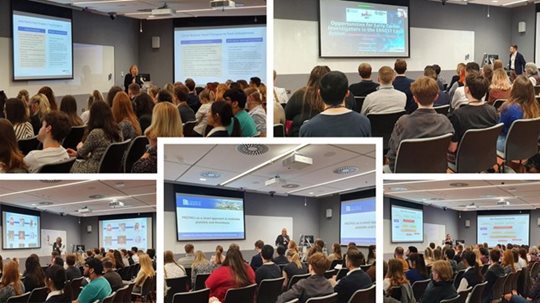
Dr Clíona MacSweeney (top left), Dr Maria Majellaro (top right), Professor Frank Gunn-Moore (bottom left), Professor Ingeborg Hers (centre) and PhD student, Beth Eyre (bottom right) engaging the audience with their research.
Apart from the keynote sessions and oral presentations, the rest of the abstracts were accepted as either poster or flash poster sessions. This provided the attendees with a more casual and intimate platform to engage in stimulating conversations. The workshops held special significance, aimed at addressing key areas such as exploring research careers in industry, writing a successful grant proposal, and mastering the art of science communication. They provided participants with the much-needed practical insight into important aspects of their future careers.
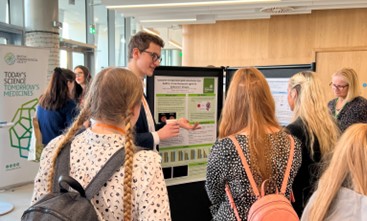
Poster sessions are the best moments to foster discussion and to disseminate research.
Prizes were kindly sponsored by BioAscent and were awarded for the best oral communication, best poster, and best flash poster presentation, developing an environment of healthy competition and recognition of exemplary work. We enlisted the help of our undergraduate volunteers and delegates on the day to score the talks and posters. Chelbi Coyle (University of Strathclyde) was awarded the best oral communication, with her talk on sex differences in pulmonary hypertension; Lara Birch (University of Glasgow) and Stefan Corradini (Glasgow Caledonian University) were both awarded a prize for the best poster, Reece Thompson (University of Strathclyde) won the best undergraduate poster, while Tianshu Qu (University of Strathclyde) was awarded the prize for the best flash talk. It was great to see their excitement once they were awarded the certificates at the end of the day. I personally want to thank the group of undergraduate students which helped with the organisation of the conference, since they played a crucial role in selecting the abstracts for the oral communications, as well as awarding the prizes for the best posters and flash talks. We would have not made it without them!
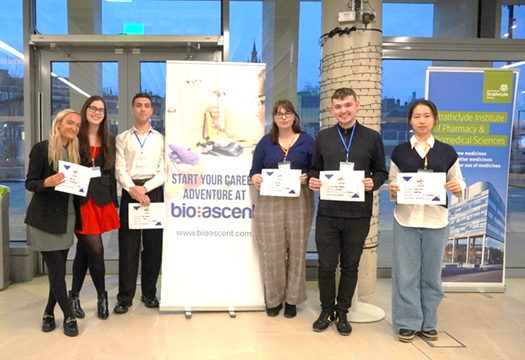
The prize winners and their certificates.
No academic gathering is complete without some form of socialising. We ended the day on a festive note, with a delightful dinner and a traditional Scottish ceilidh at the University of Glasgow Union Dining Hall with Stravaig ceilidh band. The participants not only got to let their hair down after a day filled with scientific discussions but also had a chance to experience a taste of Scottish culture.
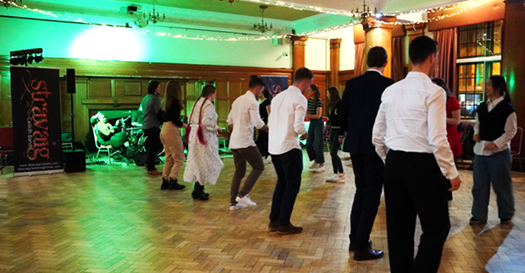
Delegates daring to ‘Strip the Willow’ to the music of Stravaig ceilidh band.
Of course, the success of this event would not have been possible without the generous support of all our sponsors: The Royal Society of Edinburgh, Alzheimer’s Research UK, BioAscent, Sosei Heptares, British Pharmacological Society, ERNEST, Strathclyde Institute of Pharmacy and Biomedical Sciences, and the Glasgow University Chancellors Fund. We want to thank every funding body involved, as they provided us with the means to bring this event to life and helping us create an engaging, beneficial, and memorable event for ECRs in the life sciences. An endeavour of this scale would not have been possible without the guidance and support of our supervisors, Dr Margaret Cunningham and Dr. Sophie Bradley. They stood by us as pillars of strength, helping us navigate the intricacies of budget management and bureaucracy that are a crucial, yet often overlooked, aspect of organising such events. From optimising the allocation of funds to guiding us through the administrative processes, their support was instrumental in shaping the symposium. Their trust in our abilities emboldened us, turning daunting challenges into surmountable obstacles. To them, we owe our deepest gratitude, for their role was not just supervisory, but they became our mentors, collaborators, and the unsung heroes of our successful symposium.
Reflecting on the symposium, it’s clear that the countless hours spent in planning, coordination, and execution paid off handsomely. The satisfaction derived from seeing ideas materialise into an event that enriched the professional and personal lives of so many attendees was immeasurable. The experience has taught me that creating a scientific symposium is much like conducting an experiment, with hypotheses, tests, failures, and successes. But the outcomes, the connections forged, knowledge shared, and the scientific community's advancement, are undeniably worth the effort.

Thanks to all the attendees that came on the day!
Photography credit: Dr Moa Safar
Comments
If you are a British Pharmacological Society member, please
sign in to post comments.